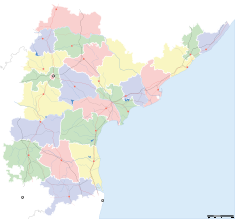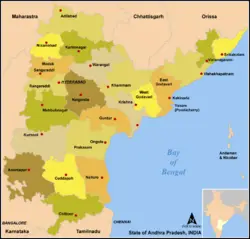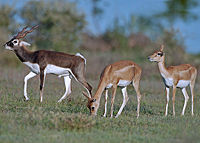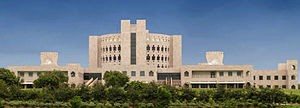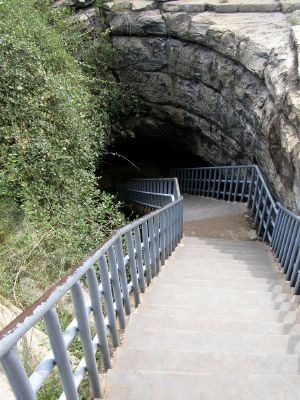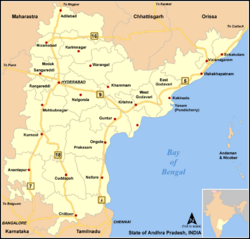Andhra Pradesh
- "Andhra" redirects here.
| ఆంధ్ర ప్రదేశ్ Andhra Pradesh India | |
| Coordinates: | |
| Time zone | IST (UTC+5:30) |
| Area | 275,068 km² (106,204 sq mi) |
| Capital | Hyderabad |
| Largest city | Hyderabad |
| District(s) | 23 |
| Population • Density |
76,210,007 (5th) • 277 /km² (717 /sq mi) |
| Language(s) | Telugu, Urdu |
| Governor | Narayan Dutt Tiwari |
| Chief Minister | Y.S. Rajasekhara Reddy |
| Established | November 1, 1956 |
| Legislature (seats) | Bicameral (295+90) |
| ISO abbreviation | IN-AP |
| Website: www.aponline.gov.in | |
| Seal of Andhra Pradesh | |
Coordinates: Andhra Pradesh (Telugu: ఆంధ్ర ప్రదేశ్, Urdu: آندھرا پردیش [aːnd̪ʱɾə pɾədeːʃ] ) or AP, the "Rice Bowl of India", is a state in southern India. It lies between 12°41' and 22°N latitude and 77° and 84°40'E longitude, and is bordered by Maharashtra, Chhattisgarh and Orissa in the north, the Bay of Bengal in the East, Tamil Nadu to the south and Karnataka to the west. Andhra Pradesh is the 4th largest state in India by area and population. It is the largest and most populous state in Southern India. The state is crossed by two major rivers, the Godavari and the Krishna. Historically this land was known as Andhrapatha, Andhra Desa, Andhra-avani, Andhra-mandalamu, Andhra-vishaya, etc.[1]
Geography
Divisions
Andhra Pradesh can be divided into Three governance regions, namely Coastal Andhra, Rayalaseema and Telangana.[2]
Andhra Pradesh has 23 districts: Adilabad, Anantapur, Chittoor, Kadapa, East Godavari, Guntur, Hyderabad, Karimnagar, Khammam, Krishna, Kurnool, Mahbubnagar, Medak, Nalgonda, Nellore, Nizamabad, Prakasam, Rangareddy, Srikakulam, Visakhapatnam, Vizianagaram, Warangal and West Godavari.
Hyderabad is the capital and along with the adjoining twin city Secunderabad, is the largest city in the state. Visakhapatnam, Andhra Pradesh's main seaport, is the second largest city of the state and is home to the Indian Navy's Eastern Naval Command .Vijayawada due to its location and proximity to major rail and road routes is a major trading center and the third largest city of the state. Other important cities and towns are:- Kurnool, Warangal, Guntur,Tirupati,Bhimavaram,Kakinada,Rajahmundry,Narsapur and Nellore
Demographics
Telugu is the regional and official language of the state, spoken by 84.86% of the population. Telugu is the second largest Spoken language in India. The major linguistic minority groups in the state include the speakers of Urdu (7.86%), the 2nd official language of Andhra Pradesh, Hindi (2.65%)
The minority language speakers who constitute less than 1% are the speakers of Tamil (0.97%), Kannada (0.94%), Marathi (0.84%), Oriya (0.42%), Gondi (0.21%) and Malayalam (0.1%). The speakers of minority languages who constitute less than 0.1% are the speakers of Gujarati(0.09%), Savara (0.09%), Koya (0.08%), Jatapu (0.04%), Punjabi (0.04%), Kolami (0.03%), Konda (0.03%), Gadaba (0.02%), Sindhi (0.02%), Gorkhali /Nepali (0.01%) and Khond /Kondh (0.01%).
Economy
Agriculture has been the chief source of income for the state's economy. Two important rivers of India, the Godavari and Krishna, flow through the state, providing irrigation. Rice, sugarcane, cotton, mirchi, Mangoes and tobacco are the local crops.Recently,crops used for vegetable oil production such as sunflower and peanuts have gained favour. There are many multi-state irrigation projects in development, including Godavari River Basin Irrigation Projects and Nagarjuna Sagar Dam, the world's highest masonary dam. [3][4]
The state has also started to focus on the fields of information technology and biotechnology. In 2004 - 2005, Andhra Pradesh was at the fifth position in the list of top IT exporting states of India. The IT exports from the State were Rs.1,800 million in 2004. The IT sector is expanding at a rate of 52.3% every year. The IT exports reached Rs.19,000 million in 2006 - 2007 and ranked fourth in India. The service sector of the state already accounts for 43% of the GSDP and employs 20% of the work force.[5]
Andhra Pradesh is a mineral rich state, ranking second in India in terms of mineral wealth. The state has about one third of India's limestone reserves, estimated at about 30 billion tonnes.[6]
The state ranks first nationwide in hydro electricity generation with national market share of over 11%.
Andhra Pradesh's gross state domestic product for 2005 was estimated at $62 billion in current prices. This is a chart of trend of gross state domestic product of Andhra Pradesh at market prices estimated by Ministry of Statistics and Programme Implementation with figures in millions of Indian Rupees. Accordingly, the state ranks third in terms of overall gross state domestic product and fourth in per capita gross state domestic product among the major states of India.
| Year | State GDP (Rs. MM) |
|---|---|
| 1980 | 81,910 |
| 1985 | 152,660 |
| 1990 | 333,360 |
| 1995 | 798,540 |
| 2000 | 1,401,190 |
| 2007 | 2,294,610 |
Government and politics
Andhra Pradesh has a Legislative Assembly of 294 seats. The state has 60 members in the Parliament of India; 18 in the Rajya Sabha, the Upper House and 42 in the Lok Sabha, the Lower House.[7][8]
Andhra Pradesh had a series of governments headed by Indian National Congress (INC) Party until 1982. Kasu Brahmananda Reddy held the record for the longest serving chief minister which was broken by N.T. Rama Rao in 1983. P.V. Narasimha Rao also served as the chief minister of the state, who later went on to become the Prime Minister of India in 1991. Among the notable chief ministers of the state are Tanguturi Prakasam, CM for only the Andhra state,[ The first Chief Minister of Andhra Pradesh, was Neelam Sanjiva Reddy], others include Kasu Brahmananda Reddy, Marri Chenna Reddy, Jalagam Vengal Rao, Nedurumalli Janardhana Reddy, Nadella Bhaskara Rao, Kotla Vijaya Bhaskara Reddy, N.T. Rama Rao, Nara Chandrababu Naidu and Y.S. Rajasekhara Reddy.
In 1983 Telugu Desam Party (TDP) won the State elections and N.T. Rama Rao (NTR) became the chief minister of the state for the first time introducing a formidable second political party to Andhra Pradesh's politics and thus breaking the virtually-single party monopoly on Andhra Pradesh's politics. After few months, Nadendla Bhaskar Rao attempted a hijack when NTR was away to the United States for a medical treatment. After coming back, NTR successfully convinced the then State Governor to dissolve the Assembly and call on for a fresh election. TDP won the elections with a large majority and NTR became Chief Minister of the State for the second time. His government policies included investment in education, rural development and in holding corrupt government officials.
In 1989 group elections ended the 7-year rule of NTR with INC party returning to power with Dr. Marri Chenna Reddy at the helm of affairs. He was replaced by N. Janardhan Reddy who was in turn replaced by Kotla Vijaya Bhasker Reddy.
In 1994, Andhra Pradesh gave a mandate to TDP again and saw NTR becoming the chief minister again. NTR died of heart attack before the next elections and again from TDP Chandrababu Naidu, the ex-finance minister won a second term before he was defeated by the INC-led coalition in the May'04 polls.
Y.S. Rajasekhara Reddy of INC, became Chief Minister of state after May 2004. Rajasekhara Reddy fought the 2004 Assembly elections in an alliance with the Telangana Rashtra Samithi (TRS), which was formed by the politician Chandrasekhar Rao whose aim is to form a separate state.
History
An Andhra Kingdom was mentioned in the Sanskrit epics such as Aitareya Brahmana and Mahabharata. Inscriptional evidence showed that there was a kingdom in coastal Andhra ruled by Kuberaka with Pratipalapura (Bhattiprolu) as his capital in 5th century B.C.E. This probably was the oldest known kingdom in Southern India. Around the same time Dhanyakatakam/Dharanikota (present day Amaravati) seemed to be a very important place. According to Taranatha: On the full moon of the month Chaitra in the year following his enlightenment, at the great stupa of Dhanyakataka, the Buddha emanated the mandala of "The Glorious Lunar Mansions" (Kalachakra).[9][10] The Mauryans extended their rule over Andhra in 4th century B.C.E. With the fall of the Mauryan Empire Andhra Satavahanas became independent in 3rd century B.C.E. After the decline of the Satavahanas in 220 C.E., Ikshvakus, Pallavas, Vishnukundinas, Ananda Gotrikas and Cholas ruled the Telugu land. Inscriptional evidence of Telugu was found during the rule of Renati Cholas (Kadapa region) in 5th century CE.[citation needed] During this period the Telugu language, emerged as a popular medium undermining the predominance of Prakrit and Sanskrit.[citation needed] Telugu was made official language by the Vishnukundina Kings[citation needed] who ruled from their capital Vinukonda. Eastern Chalukyas ruled for a long period after the decline of Vishnukundinas from their capital in Vengi. As early as 1st century CE, they were mentioned as being vassals and chieftains under the Satavahanas and later under Ikshvakus.
The battle of Palnadu resulted in the weakening of Chalukyan power and emergence of the Kakatiyadynasty in the 12th and the 13th centuries CE.
The Kakatiyas were at first feudatories of the Western Chalukyas of Kalyani, ruling over a small territory near Warangal. In 1323 C.E., Delhi Sultan Ghiaz-ud-din Tughlaq sent a large army under Ulugh Khan to conquer the Telugu country and capture Warangal. King Pratap Rudra was taken prisoner. Musunuri Nayaks recaptured Warangal from the Delhi Sultanate and ruled for fifty years. The Vijayanagar empire, one of the greatest empires in the history of Andhra Pradesh and India, was founded by Harihara and Bukka, who served as treasury officers of the Kakatiyas of Warangal.[11] In 1347 C.E., an independent Muslim state, the Bahmani kingdom, was established in south India by Alla-ud-din Hasan Gangu as a revolt against the Delhi Sultanate. The Qutb Shahi dynasty held sway over the Andhra country for about two hundred years from the early part of the 16th century to the end of the 17th century.
In Colonial India, Northern Circars became part of the British Madras Presidency. Eventually this region emerged as the Coastal Andhra region. Later the Nizam had ceded five territories to the British which eventually emerged as Rayalaseema region. The Nizams retained control of the interior provinces as the Princely state of Hyderabad, acknowledging British rule in return for local autonomy.
India became independent from the United Kingdom in 1947. The Muslim Nizam of Hyderabad wanted to retain his independence from India, but the people of the region launched movement to join Indian Union. His state of Hyderabad was forced to become part of the Republic of India in 1948, after Indian Military Occupation as Hyderabad State.
In an effort to gain an independent state, and protect the interests of the Telugu people of Madras State, Amarajeevi Potti Sriramulu fasted until death. Public outcry and civil unrest after his death forced the government to announce the formation of a new state for Telugu speakers. Andhra attained statehood in October 1953 with Kurnool as its capital.
On 1 November 1956, Andhra State merged with the Telangana region of Hyderabad State to form the state of Andhra Pradesh. Hyderabad, the former capital of the Hyderabad State, was made the capital of the new state Andhra Pradesh.
Culture
Cultural institutions
Andhra Pradesh has many museums, including the Archaeological Museum at Amaravati near Guntur City that features relics of nearby ancient sites, the Salar Jung Museum in Hyderabad, which features a varied collection of sculptures, paintings, and religious artifacts, the Visakha Museum in Vizag (Visakhapatnam), which displays the history of the pre-Independence Madras Presidency in a rehabilitated Dutch bungalow and Victoria Jubilee Museum in Vijayawada, which has a nice collection of ancient sculptures, paintings, idols, weapons, cutlery, and inscriptions.
Cuisine
The cuisine of Andhra Pradesh is reputedly the spiciest of all Indian cuisine. There are many variations to the Andhra cuisine depending on caste, geographical regions, traditions etc. Pickles and chutneys, called pachchadi in Telugu are particularly popular in Andhra Pradesh and many varieties of pickles and chutneys are unique to the state. Chutneys are made from practically every vegetable including tomatoes, brinjals, and roselle (Gongura, ). The mango pickle Aavakaaya is probably the best known of the Andhra pickles.
Rice is the staple food and is used in a wide variety of ways. Typically, rice is either boiled and eaten with curry, or made into a batter for use in a crepe-like dish called attu (pesarattu) or dosas.
Meat, vegetables, and greens are prepared with different masalas into a variety of strongly flavored dishes.
Hyderabadi cuisine is influenced by the Muslims who arrived in Telangana in the 14th century. Much of the cuisine revolves around meat. It is rich and aromatic, with a liberal use of exotic spices and ghee. Lamb, chicken and fish are the most widely used meats in the non-vegetarian dishes. The biryani is perhaps the most distinctive and popular of Hyderabadi dishes.
Dance
Jayapa Senani (Jayapa Nayudu) is the first person who wrote about the dances prevalent in Andhra Pradesh [12]. Both Desi and Margi forms of dances have been included in his Sanskrit treatise 'Nritya Ratnavali'. It contains eight chapters. Folk dance forms like Perani, Prenkhana, Suddha Nartana, Carcari, Rasaka, Danda Rasaka, Shiva Priya, Kanduka Nartana, Bhandika Nrityam, Carana Nrityam, Chindu, Gondali and Kolatam are described. In the first chapter the author deals with discussion of the differences between Marga and Desi, Tandava and lasya, Natya and Nritta. In the 2nd and 3rd chapters he deals with Angi-kabhinaya, Caris, Sthanakas and Mandalas. In the 4th Chapter Karnas, angaharas and recakas are described. In following chapters he described the local dance forms i.e. desi nritya. In the last chapter he deals with art and practice of dance.
Classical dance in Andhra can be performed by both men and women; however women tend to learn it more often. Kuchipudi is the state's best-known classical dance forms of Andhra Pradesh. The various dance forms that existed through the states’ history are Chenchu Bhagotham, Kuchipudi, Bhamakalapam, Burrakatha, Veeranatyam, Butta bommalu, Dappu, Tappeta Gullu, Lambadi, Bonalu, Dhimsa, and Kolattam.
Festivals
- Sankranthi in January.
- Maha Shivaratri in February/March.
- Ugadi or the Telugu New Year in March/April.
- Rama Navami celebrated in March/April 9 days after Ugadi.
- Varalakshmi Vratham in August.
- Vinayaka Chavithi in August.
- Dasara in September/October.
- Atla Tadde 3rd day in bright half of Aswiyuja month (falls in September/October in Gregorian calendar)
- Deepavali in October/November.
- Bonalu in Sravanam. (Celebrated in Telangana region).
- Bathukamma celebrated during September/October in Telangana region.
Literature
Telugu literature is highly influenced by Sanskrit literature and Hindu scriptures. Nannayya, Tikkana, and Yerrapragada form the trinity who translated the great epic Mahabharatha into Telugu. Bammera Potana is another great poet from Orugallu (Now Warangal) famous for his great classic Sri Madandhra Maha Bhagavatamu, a Telugu translation of 'Sri Bhagavatham' authored by Veda Vyasa in Sanskrit. Nannayya derived the present Telugu script(lipi) from the old Telugu-Kannada script. Emperor Krishna Deva Raya wrote Amuktamalyada and also made the famous statement : "Desa Bhashalandu Telugu lessa". Philosophical poems by Yogi-Vemana are quite famous. Modern writers include Jnanpith Award winners Sri Viswanatha Satya Narayana and Dr. C. Narayana Reddy. Revolutionary poets like SriSri and Gaddar are popular.
Mohammad Quli Qutub Shah was the first Deewan Shayar of Urdu Literary History. Makhdoom Mohiuddin regarded as revolutionary poet. Many classical writers like, Wali Mohammed Wali Dakhni, Amjad Hyderabadi, Charagh Hyderabadi, Aqeel Hashmi, Suleman Athhar Javed, Aslam Farshori, Ahmadnisar, Barq Kadapavi, Qamar Ameeni, and many others.
Movies
Andhra Pradesh is the state with the most cinema halls in India, at around 3000[citation needed]. The state also produces about 200[citation needed] movies a year. It has around 40% (330 cinema halls out of 930 DTS cinema halls in India ([1]) of all the Dolby digital theatres in India. Now it also houses an IMax theatre with a big 3D screen and also 3-5 multiplexes. It is also the largest movie industry in India, producing more movies than any other industry.
Music
The state has a rich musical heritage. Legends of the Carnatic music (that started during Vijayanagara Dynasty's Sri Krishna Deva Raya) Trinity - Thyagaraja were of Telugu descent. Other great composers include Annamacharya, Kshetrayya, and Bhadrachala Ramadasu. However, Telugu film (called Tollywood) music is popular now. Folk songs are also popular in the rural belt.
State symbols
- State language - Telugu
- State symbol - Poorna Kumbham
- State song - Maa telugu thalliki by Sankarambadi Sundarachari
- State animal - Blackbuck, (Krishna Jinka)
- State bird - Indian Roller, (Paala Pitta)
- State tree - Neem (Vepa)
- State sport - Kabaddi, in Telugu Chedugudu
- State dance - Kuchipudi, Andhra Natyam
- State flower - Water lily
Other Cultural Elements
Bapu's paintings, Nanduri Subbarao's Yenki Paatalu (Songs on/by a washerwoman called Yenki), mischievous Budugu (a character by Mullapudi), Annamayya's songs, Aavakaaya (a variant of mango pickle in which the kernel of mango is retained), Gongura (a chutney from Roselle plant), Atla saddi (a seasonal festival predominantly for teenage girls), banks of river Godavari, Dudu basavanna (The ceremonial ox decorated for door-to-door exhibition during the harvest festival Sankranti) have long defined Telugu culture. The village of Durgi is known for originating stone craft, carvings of idols in soft stone that must be exhibited in the shade because they are prone to weathering.
Education
Andhra Pradesh is served by more than 20 leading institutes of excellence in higher education. All major arts, humanities, science, engineering, law, medicine, business and veterinary science are offered, leading to first degrees as well as postgraduate awards. Advanced research is conducted in all major areas.
Andhra Pradesh has 1330 arts, science and commerce colleges, 238 engineering colleges and 53 medical colleges. The student to teacher ratio is 19:1 in the higher education. According to census taken in 2001, Andhra Pradesh has an overall literacy rate of 60.5%. While male literacy rate is at 70.3%, the female literacy rate however is only at 50.4%, a cause for concern.
The state has recently made strides in setting up several institutes of high quality. International Institute of Information Technology (IIIT) and Indian School of Business (ISB) are gaining international attention for their standards. National Institute of Fashion Technology, Hyderabad (NIFT)[2]is well reputed among those interested in a career in fashion.
Major Universities/Institutes in Andhra Pradesh:
- T.R.R Govt.Degree College, Kandukur , Prakasam (Dt.)
- Badruka College of Commerce, Hyderabad
- Birla Institute Of Technology [BITS], Hyd
- B.T College Madanapalli
- IIIT, Hyderabad [International Institute of Information Technology]
- National Institute of Technology NIT, Warangal
- Acharya N. G. Ranga Agricultural University: Andhra Pradesh Agricultural University, Hyderabad
- Sri Venkateswara Veterinary University, Tirupathi (Veterinary science has been separated from N.G. Ranga Agri. University to form this separate university)
- Dr. B. R. Ambedkar Open University: Andhra Pradesh Open University, Hyderabad
- Acharya Nagarjuna University, Guntur
- Andhra University, Visakhapatnam
- Dr. NTR University of Health Sciences, Vijayawada
- Indian Institute of Planning and Management IIPM, Hyderabad
- Jawaharlal Nehru Technological University, Hyderabad
- Kakatiya University, Warangal
- Maulana Azad National Urdu University, Hyderabad
- Osmania University, Hyderabad
- Telangana University, Nizamabad
- Potti Sreeramulu Telugu University, Hyderabad
- Sri Venkateswara University, Tirupati
- Sri Padmawati University, Tirupati
- Sri Krishnadevaraya University, Anantapur
- Sri Sathya Sai University, Puttaparthi
- University of Hyderabad, Hyderabad
- ICFAI University, Hyderabad
- NALSAR University of Law, Hyderabad
- GITAM University ,Visakhapatnam
- Sri Yerramilli Narayanamurthy College, Narsapur
(See also List of institutions based in Hyderabad India)
- C.K.S. Teja Institute of Dental Sciences and Research,Tirupati
Newspapers
Andhra Pradesh has several newspapers. Some of them are:
- Telugu Newspapers - Eenadu, Prajasakti, Andhra Jyothi, Vaartha, Andhra Bhoomi, Visalandra, Hyderabad Mirror, saakshi,Surya,Udayam and Andhra Prabha
- Urdu Newspapers - Siasat Daily, Munsif Daily, Rehnuma-e-Deccan, Itimad Urdu Daily and The Milap Daily.
- English Newspapers - Deccan Chronicle, The Hindu, The Times of India, Indian Express, The Economic Times, The Business Line
Tourism
Andhra Pradesh is the home of many religious pilgrim centres. Tirupati, the abode of Lord Venkateswara, is the richest and most visited religious center (of any faith) in the world. Srisailam, the abode of Sri Mallikarjuna, is one of twelve Jyothirlingalu in India, Amaravati's Siva temple is one of the Pancharamams, and Yadagirigutta, the abode of an avatara of Vishnu, Sri Lakshmi Narasimha. The Ramappa temple and Thousand Pillars temple in Warangal are famous for some fine temple carvings. The state has numerous Buddhist centres at Amaravati, Nagarjuna Konda, Bhattiprolu, Ghantasala, Nelakondapalli, Dhulikatta, Bavikonda, Thotlakonda, Shalihundam, Pavuralakonda, Sankaram, Phanigiri and Kolanpaka.
The golden beaches at Visakhapatnam,the one-million-year old limestone caves at Borra, picturesque Araku Valley, hill resorts of Horsley Hills, river Godavari racing through a narrow gorge at Papi Kondalu, waterfalls at Ettipotala, Kuntala and rich bio-diversity at Talakona, are some of the natural attractions of the state.
The Borra Caves are located in the Anatagiri Hills of Eastern Ghats, near Vishakapatnam, Andhra Pradesh State in India. They are at a height of about 800 to 1300 metres above Mean Sea Level and are famous for millions of years old stalactite and stalagmite formations. They were discovered by William King George, the British geologist in the year 1807.The caves get their name from a formation inside the caves that looks like the human brain, which in the local language, Telugu, is known as borra.Similarly Belum caves was formed due to erosion in limestone deposite in the area by Chitravati River, millions of years ago. This limestone caves was formed due to action of carbonic acid — or weakly acidic groundwater formed due to reaction between limestone and water.
Belum Caves are the second largest cave in Indian sub-continent and the longest caves in plains of Indian Subcontinent. Belum Caves derives its name from "Bilum" Sanskrit word for caves. In Telugu language, it is called Belum Guhalu. Belum Caves has a length of 3229 meters, making it the second largest natural caves in Indian Subcontinent. Belum Caves have long passages, spacious chambers, fresh water galleries and siphons. The caves reach its deepest point (120 feet from entrance level) at the point known as Patalganaga.
Horsley Hills Horsley Hills, elevation 1,265 m, is a famous summer hill resort in Andhra Pradesh, about 160 km from Bangalore, India and 144 km from Tirupati. The town of Madanapalle lies nearby. Major tourist attractions include the Mallamma temple and the Rishi valley school. Horsely Hills is the departure point for the Koundinya Wildlife Sanctuary at a distance of 87 km.
Many scary and spookyBollywood films are shot here, and it is also famous for its Banyan tree which is many years old[citation needed]. Horsley Hills is named after a British officer named W.D. Horsley, the Collector of Cuddapah district, who chose this spot for his summer residence.
The narrow road to Horsely Hills is very scenic. It is surrounded throughout its entire length with dense growths of eucalyptus, jacaranda, allamanda, and gulmohar trees. This place is also believed to be haunted by some ghosts.
Charminar, Golconda Fort, Chandragiri Fort, Chowmahalla Palace and Falaknuma Palace are some of the monuments in the state.
Transport
There are six airports in the state namely, Hyderabad (Rajiv Gandhi International), Visakhapatnam, Vijayawada (Gannavaram), Rajahmundry (Madhurapudi) and Tirupati (Renigunta). Government also have plans to start airports in 6 other cities including Nellore, Warangal, Kadapa, Tadepalligudem, Ramagundam and Ongole.
Andhra Pradesh State Road Transport Corporation (APSRTC) is the major public transport corporation owned by government of Andhra Pradesh connecting all the cities and villages. APSRTC also has the distinction of being in the Guinness book of World records for having the largest fleet of vehicles, and the longest area covered/commuted daily. Apart from these thousands of private operators run buses connecting major cities and towns of the state. Private vehicles like auto rickshaws occupy a major share of the local transport in the cities and adjoining villages.
Andhra Pradesh also has two of the important ports of India at Visakhapatnam and Kakinada and two minor ports Machilipatnam and Krishnapatnam.
Famous People from Andhra Pradesh
See List of people from Andhra Pradesh
See also
- History of India
- Middle kingdoms of India
- Andhra state
- Rivalry and Tribute: Society and Ritual in a Telugu village in South India by Bruce Elliot Tapper
Notes
- ↑ A Study of Telugu Place-names By S. S. Ramachandra Murthy, P. 10
- ↑ AP Cabinet approves four regional planning boards.
- ↑ Agriculture dept. of Andhra Pradesh.
- ↑ Key Sectors of Andhra Pradesh.
- ↑ Key Sectors of Andhra Pradesh.
- ↑ Key Sectors of Andhra Pradesh.
- ↑ Andhra Pradesh Legislative Assembly.
- ↑ Parliament of India.
- ↑ Helmutt Hoffmann, "Buddha's Preaching of the Kalachakra Tantra at the Stupa of Dhanyakataka," in: German Scholars on India, Vol. I. PP. 136-140. (Varanasi, 1973)
- ↑ Taranatha; http://www.kalacakra.org/history/khistor2.htm
- ↑ Robert Sewell, A Forgotten Empire (Vijayanagar): A contribution to the history of India, Chapter 2 (http://www.gutenberg.org/dirs/etext02/fevch10.txt
- ↑ Ntitya Ratnavali (http://www.telugupeople.com/discussion/article.asp?id=111
18. http://www.dae.gov.in/ni/nijul03/cudapah.pdf
Heal - Health and Education for All - Children's charity in Andhra Pradesh
External links
- Travel guide to Andhra Pradesh from Wikitravel
- Andhra Pradesh Government *
- {{{2}}} at the Open Directory Project
| ||||||||||||||
| ||||||||||
[[Category:]]
Credits
New World Encyclopedia writers and editors rewrote and completed the Wikipedia article in accordance with New World Encyclopedia standards. This article abides by terms of the Creative Commons CC-by-sa 3.0 License (CC-by-sa), which may be used and disseminated with proper attribution. Credit is due under the terms of this license that can reference both the New World Encyclopedia contributors and the selfless volunteer contributors of the Wikimedia Foundation. To cite this article click here for a list of acceptable citing formats.The history of earlier contributions by wikipedians is accessible to researchers here:
The history of this article since it was imported to New World Encyclopedia:
Note: Some restrictions may apply to use of individual images which are separately licensed.
